After a tour of the shrine grounds (see Part One), Barrish sensei and I moved towards the entrance of the shrine buildings before which stands the temizuya (water basin). It’s not often at a Shinto shrine you get to see the instructions for the ritual washing in English. Nor indeed will you find many shrine bells inscribed with the name of a foreigner. In this case the name of the foreigner just happened to be mine!
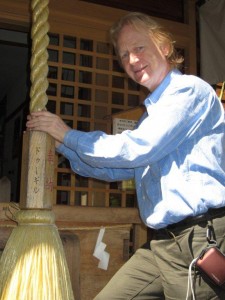
The Haiden (Worship Hall) is a large spacious room of tatami, which is used four times a week for people to train in aikido. At the altar are all the trappings one would expect, though in more pristine form than one finds in older shrines. The main kami enshrined are those of Tsubaki in Japan, namely the mythological figures Sarutahiko-no-O-Kami and his wife Ame no Uzume. In addition, there are four other kami here, including protector of the N. American continent, America Kokudo Kunitama-no-Kami.
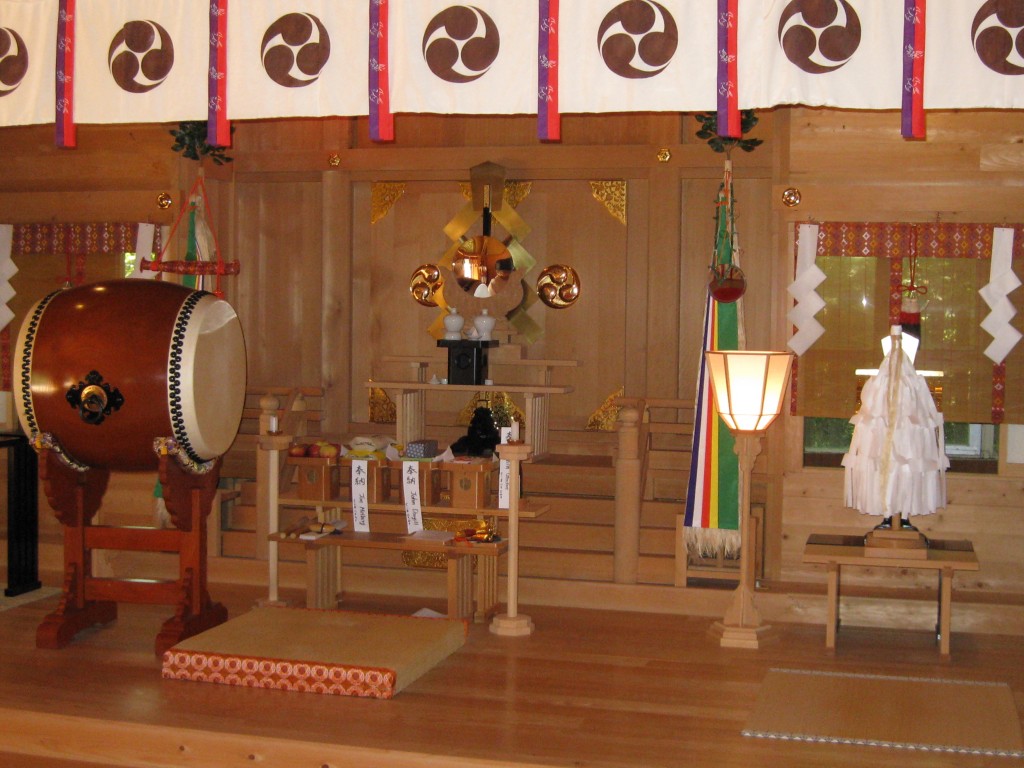
Mirror, drum, triple tomoe and other shrine trappings
Shrine operations
Before getting an oharae purification from Rev. Barrish, I went upstairs with him for an informal chat and took the opportunity to ask a few questions. How had he managed to set up such an impressive shrine? It seems he invested savings from his aikido teaching (he has an international reputation, having introduced the martial art to the Soviet Union in the 1980s). Through dedication and hard work he’s managed to build up the shrine to where it’s now financially independent. There is too a solid base of supporters: rather than the ujiko parishoners on which Japanese shrines rely, there are some 450 ‘sukeiya‘ who form the shrine membership. Most are non-Japanese.
I thought perhaps that Japanese-Americans would comprise the bulk of shrine-goers, as in Hawaii, but it seems that nearly half the visitors are in fact Japanese nationals, temporarily in the U.S. for one reason or another. How did they react to a Caucasian priest, I wondered? ‘Once they experience Oharae and Go-kito-kigansai, they are always very happy,’ came the answer.
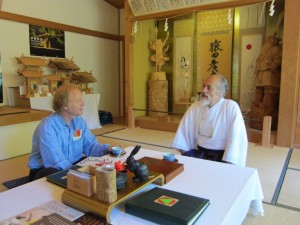
Cultural exchange
Shinto in the West
Amongst other topics covered was the matter of Shinto’s appeal in the West, which we agreed has much to do with its positive and life-enhancing quality. For myself I see it developing in the direction of spiritual practice, much as Daoism has done in transferring to the West, whereby individual faith replaces communal tradition. For his part Barrish sensei pointed out that gatherings like New Year, 7-5-3 and the annual festival draw large groups of people. Moreover, shrine supporters often practise other faiths. One notable member, for instance, is a bishop in the Greek Orthodox church.
The use of language
One point that intrigued me was the retention of Japanese terms for everything. Wasn’t the profusion of words like omamaori, ofuda, kamidana, gohei, oharae, temizuya etc etc overwhelmeing for anyone not familar with Japanese? How could Westerners cope with longwinded names like Ame-no-Murakumo-Kukisamuhara-Ryu-O? Surely it would be easier and more accessible to anglicise everything, I proposed.
Barrish’s response was that much gets lost in translation and that English words are culturally loaded. Temizuya for instance is more than a water basin, and ‘spirit-body’ carries altogether different connotations from goshintai. It reminded me how Catholic missionaries in the sixteenth century ran into catastrophic problems trying to translate Christian terms into Japanese, for the words they used were Buddhist. God for example was translated as Dainichi. As a result, people thought the missionaries were simply a new sect of Buddhism.
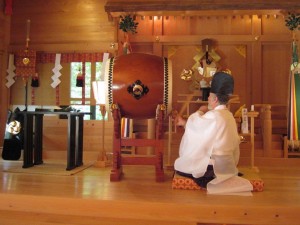
Drumming up the spirits
Green Issues
So what about the political and environmental dimensions of Shinto? What for instance are Westerners to do about reverence for the emperor which the official face of Japanese Shinto is keen to promote? Rev. Barrish said he took a non-commital stance on the issue. One of the shrines I visited in Hawaii had replaced Japanese patriotism and reverence for the emperor with American patriotism and reverence for the president. I wondered if that was a possible direction here too, but Barrish said he had no interest in it. Rather he was drawn to the environmental aspect of Shinto and was thinking of celebrating Earth Day with raising the Earth flag. Green Shinto gives that a big thumbs up.
Final rites
Following our discussions, there was a short interval while Rev. Barrish donned his ritual attire and we proceeded downstairs to the shrine where he performed a purification ritual, complete with the loud banging of a drum to signify beginning and end. Following the three-fold sweep of the haraigushi (purification wand), there was a recital of norito prayers in Japanese to preserve the ‘word-magic’, or kotodama. It marked a satisfying conclusion to a stimulating visit. The Tsubaki Shrine is a pioneer of historic significance, run by a non-Japanese and catering to Japanese and non-Japanese alike. Will it prove to be a unique experiment, or the model for many more to come? Either way, here is history in the making…
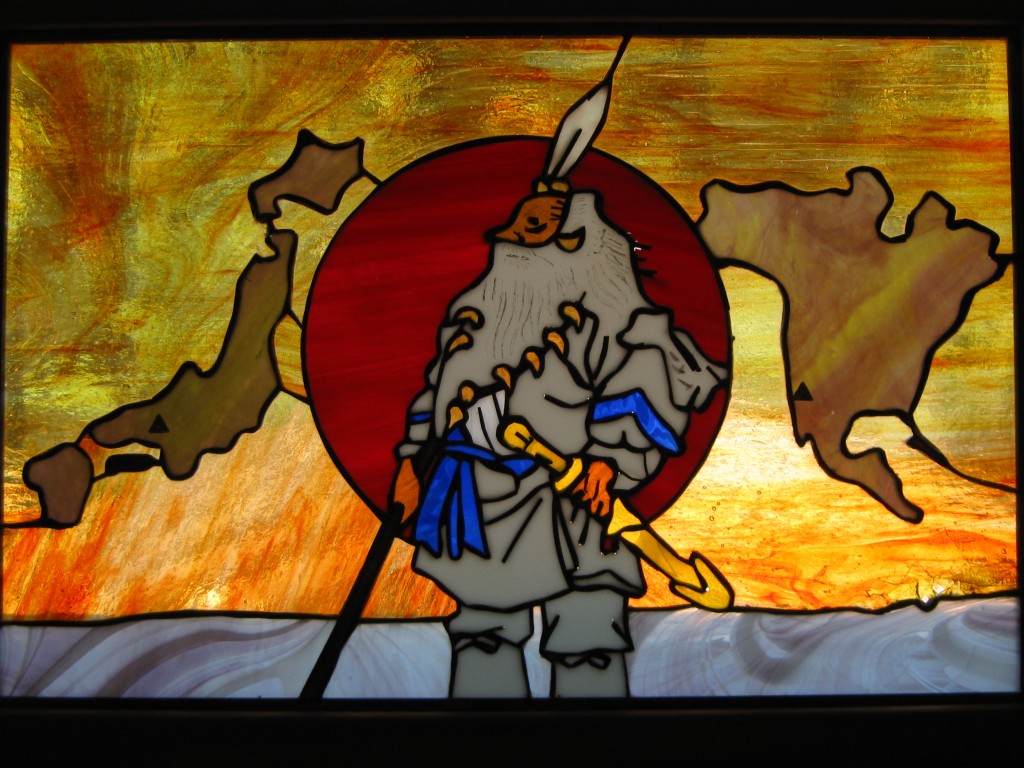
Stained glass showing the kami Sarutahiko bridging the divide between Japan and the US

Great review and photos. I’m glad you got the chance to visit Tsubaki :)
Thanks so much for this!
As a polytheist and an animist, as well as a college professor of religion, the Tsubaki Grand Shrine of America has become extremely important to me, and to many of my students. We’re very lucky to have it here locally!
Through my attendance at Shrine events (I’m not a “paid” member at present, but I get to almost all the annual festivals, as well as visiting at other times, bringing guests when they’re in town, having ceremonies for family for particular reasons, etc., and thus help in those ways to “keep them in business,” as it were!), Shinto has had a profound influence over my own spiritual life in the last five years. I’ve developed a misogi-like ritual in my practice, for example, after having done it at the Shrine, and I think in many other ways it will become even more influential with what I have done in the future.
Great blog in general! :)
Thank you for the input… It’s good to hear of the pioneering work being done at Tsubaki USA and of the attachment many people have to the shrine there. It’s certainly in an inspiring setting…